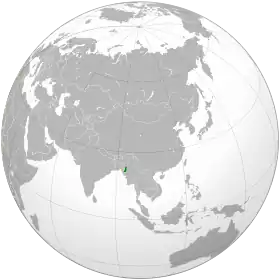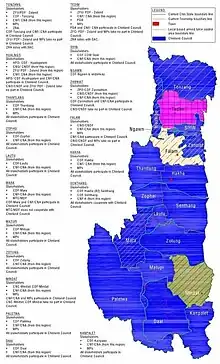State of Chinland | |
|---|---|
 Flag | |
| Anthem: Chin National Anthem | |


| |
| Status | Self-declared state de jure part of Myanmar |
| Capital | Hakha (claimed) Thantlang (de facto) |
| Official languages | Burmese, Hakha, Hualngo |
| Regional languages | Daai, Falam, Hakha, Hualngo, Lautu, Mara, Sizang, Tedim, Zanniat, Zou, Zophei |
| Ethnic groups | Chin people, Myanmar Mizos |
| Demonym(s) | Chin |
| Government | Provisional government |
• President | Pu Zing Cung |
| Legislature | Chinland Council |
| Self-declared state | |
• Chin Hills Regulation Act | 13 August 1896 |
• Chin Forum Initiative | 1998 |
• Chinland Council | 13 April 2021 |
• Chinland Constitution | 6 December 2023 |
| Area | |
• Total | 36,018.8[1] km2 (13,906.9 sq mi) |
| Population | |
• 2014 census | 578,801[2] |
• Density | 16/km2 (41.4/sq mi) |
| Currency | Kyat (K) (MMK) |
Chinland, officially the State of Chinland, is a self-declared state in Southeast Asia. Its claimed territory encompasses Myanmar's Chin State.[3] Although internationally unrecognized, it controls nearly all of the Chin State in western Myanmar, along the borders with Bangladesh and Mizoram of India.
History

The state was established following the ratification of the Chinland Constitution on 6 December 2023 by the Chin National Front (CNF) and local administration organizations, establishing the Chinland Council as its governing body and changing the former name of Chin State to Chinland. The constitution aimed at creating a nation-state for the Chin people following the principles of self-determination.[3]
The Chinland Council, composed of 27 CNF members, 14 MPs and 68 members of local administrations, received the support of 14 of the 17 recognized local administration organizations in Chin State, with the exception of Falam, Tedim and Mindat.[3]
Structure
Chinland's government is divided in three branches — executive, legislative and judiciary — overseen by the Chinland Council, expected to fully establish the three branches by January 2024. The executive is expected to include 15 ministries, among which ministries for Defense, Home Affairs, Foreign Affairs and Immigration.[3]
The Chinland Constitution also establishes the Chin National Army as the state's only national army. Nonetheless, local administrations still maintain their own armed forces, most of them as part of the Chinland Defense Force and organized in the Chin Joint Defense Committee.[3]
Administrative divisions

- Daai
- Falam
- Hakha
- Hualngo
- Kanpetlet
- Lautu
- Matupi
- Mara
- Mindat
- Ngawn
- Paletwa
- Senthang
- Siyin
- Tedim
- Tonzang
- Thantlang
- Zanniat
- Zophei
- Zotung
Symbols
A new flag was established for Chinland, differing from the Chin State's previous flag. It consists of three horizontal bands of red, white and blue, charged with two hornbills in the center.
Status
While claiming to strive for a "federal democracy union", the constitution did not discuss Chinland's status with respect to Myanmar, leading to speculation about potential separatism.[3]
Furthermore, some members of the previous Interim Chin National Consultative Council, established in 2021, have rejected the authority of the Chinland Council, fearing a ratification of the constitution would lead to the dissolution of the ICNCC.[3]
See also
References
- ↑ "Union of Myanmar". City Population. Retrieved 10 April 2009.
- ↑ Census Report. The 2014 Myanmar Population and Housing Census. Vol. 2. Naypyitaw: Ministry of Immigration and Population. May 2015. p. 17.
- 1 2 3 4 5 6 7 "The First Chin-Written Constitution: A New Template For Self-Determination?". The Irrawady. 26 December 2023. Archived from the original on 26 December 2023.